Digital Compliance: Are Online Labor Law Posters the Future?

Work in the United States has changed more in the last few years than in the past several decades. With many people now working remotely or in hybrid setups, employers face a tough question: how can they follow labor laws when an employee’s “workplace” might be their home or a laptop on the kitchen table? A key issue is whether digital labor law posters can really take the place of the traditional ones hung in office break rooms and what that change could mean for following the rules in the future.
The Traditional Labor Law Poster Requirement
Federal law says that any employer with at least one employee must display certain labor law posters where workers can easily see them. These posters explain employee rights under laws such as:
- The Fair Labor Standards Act (FLSA)
- The Family and Medical Leave Act (FMLA)
- The Occupational Safety and Health Act (OSHA)
- Equal Employment Opportunity (EEO) laws
The U.S. Department of Labor requires these posters to be placed “in every establishment where employees work so they can easily see them.” Traditionally, that means posting them on a bulletin board in a break room or near a time clock.
Not following these rules can be expensive. As of 2025, fines include:
- $698 for missing the EEOC “Know Your Rights” poster
- $216 for FMLA poster violations
- $16,550 for OSHA poster issues
- $26,262 for Employee Polygraph Protection Act violations
If an employer misses all required federal posters, the total fines could add up to more than $43,700 per location, a clear sign that staying compliant is essential.
The Rise of Remote Work and Digital Posting Needs
Remote work didn’t just change where people work, it changed how compliance works. Around 13.8% of the U.S. workforce, or about 22.5 million people, now work from home. That shift raises a simple but messy question, for example, how can employees read posters they never walk past?
The Department of Labor acknowledged this issue with its Field Assistance Bulletin 2020-7, issued on December 29, 2020. The bulletin offered guidance on when digital posting might meet federal requirements, a small but notable recognition that compliance needs to catch up to reality.
When Electronic Posting Is Permitted: Federal Guidelines
According to the DOL’s bulletin, digital posting counts only in specific cases:
- Fully remote workforces – Employers can rely solely on digital postings only if every employee works remotely. If even one person reports to a physical site, hard copies are still required there.
- Established digital communication – The company must already use electronic means, like intranets or emails, to share official workplace information.
- Unrestricted access – Employees need to be able to access the postings anytime, without jumping through hoops. Employers must clearly explain where to find them.
Even then, the DOL generally prefers a mix of both digital and physical postings. For most employers, electronic versions are meant to supplement, not replace, the paper ones.
State-Level Digital Posting Requirements
Several states have gone further than the federal government:
- New York (since Dec. 16, 2022): Employers must make digital versions of all required labor posters available online or by email, while still keeping physical copies up at work.
- Illinois (since Jan. 1, 2024): Employers with remote staff must distribute four key labor notices electronically either via email or on an internal website.
- Ohio (effective July 20, 2025): Became the first state to let employers choose between physical or digital posting for certain state notices, such as the Minimum Wage and Workers’ Compensation posters. This move could mark a broader trend toward digital-first compliance.
Other states like Colorado, Oregon, Arizona, Maine, and Washington have issued similar digital-friendly guidance, though not all require it yet.
Advantages of Digital Labor Law Posters
Labor Law Posters Online brings several benefits that make sense in a dispersed workplace:
- Accessibility: Remote workers can view posters at any time, from anywhere, through company intranets or email links.
- Instant updates: When labor laws change, employers can update digital posters immediately instead of reprinting and replacing paper ones.
- Lower costs: Businesses save on printing, laminating, and shipping expenses, especially valuable for companies with multiple sites.
- Environmental benefit: Less paper, less waste.
- Better tracking: Employers can verify who viewed or acknowledged the posters, providing an extra layer of compliance documentation.
- Easy scaling: Digital systems can instantly adapt as companies expand to new states or hire more remote employees.
Challenges and Limitations of Digital Posting
Still, this shift isn’t without friction:
- Regulatory limits: Federal rules still require physical postings in most workplaces with on-site staff.
- Tech barriers: Not every employee has steady internet access or a suitable device, particularly in manufacturing or field-based jobs.
- Visibility problems: Digital posters can be easily ignored if employees aren’t reminded where to find them.
- State inconsistencies: Employers operating across multiple states may find it confusing to track differing rules on digital posting.
In short, while digital solutions appear efficient, they may not yet be sufficient on their own.
The Future: A Hybrid Compliance Model
Looking ahead, labor law compliance is likely moving toward a hybrid model that blends both approaches. Physical posters aren’t going away soon, but digital postings will increasingly fill the gaps for remote and hybrid teams.
States like Ohio seem to be testing the waters for digital-only compliance, and others may follow as comfort with technology grows. Some experts even suggest that AI-based compliance tools and blockchain verification could soon make monitoring and proof of posting nearly automatic.
For now, employers might do well to think pragmatically: maintain physical postings where required, and pair them with digital versions for remote access. Many turn to compliance vendors such as Labor Law Posters Online for automatic updates and monitoring tools that reduce the guesswork.
Conclusion
Digital labor law posters are an important step in updating workplace rules for the modern world, but the change isn’t fully done yet. Right now, online posters can’t completely replace physical ones under federal law, but they are quickly becoming essential.
More states are likely to allow digital posters as they update old rules to fit today’s way of working. Employers who start using both digital and physical posters now will probably avoid legal problems later. In the end, it doesn’t matter if employees read their rights on a wall or on a screen; what’s important is making sure everyone knows their rights. Being open and honest about workplace rights has always been the foundation of fair employment.

Source: Digital Compliance: Are Online Labor Law Posters the Future?


